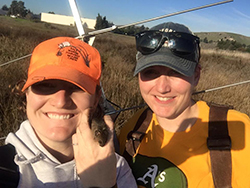

Deep in the pickleweed in the San Francisco, San Pablo and Suisun Bays, the tiny salt marsh harvest mouse (Reithrodontomys raviventris) tries to avoid predators and compete with other species for prime habitat. Food and cover are abundant, but its overall habitat is shrinking as humans encroach upon its home range. In south San Francisco Bay alone, 95 percent of the historic salt marsh has been lost to industrial parks and subdivisions. Annual flooding in the winter can be perilous, too -- when vegetation is topped by rising tides, the mice must scramble to find taller vegetation or into upland habitat (grasses around the wetlands that don’t get flooded by the tides).
As part of the effort to monitor and conserve this state- and federally-listed endangered species, biologists conduct annual surveys of the salt marsh harvest mouse. The effort involves setting up traps stuffed with cotton batting and baited with birdseed and walnuts, taking measurements and collecting other data on the subjects that are captured. In some studies, the mice are fitted with GPS collars for tracking, or ear tags to help identify them upon recapture. In other studies, the biologists simply clip away fur on the mouse’s flank or neck – another method that helps them determine whether a mouse in a trap has crossed paths with them before.
Once a mouse’s measurements have been recorded, they are set loose to scamper back into the pickleweed. The data that’s been collected will later be entered into a larger database that will be accessible to researchers from multiple state agencies (CDFW, the Department of Water Resources), federal agencies (US Fish and Wildlife Service, the US Geological Survey), educational research institutions (UC Davis, CSU San Marcos, San Francisco State) and private industry.
By comparing population fluctuations and other data throughout the range, scientists hope to identify threats and increase their understanding of this rare rodent’s biology and behavior – ultimately helping to better inform future decisions on habitat management, restoration and enhancement efforts.